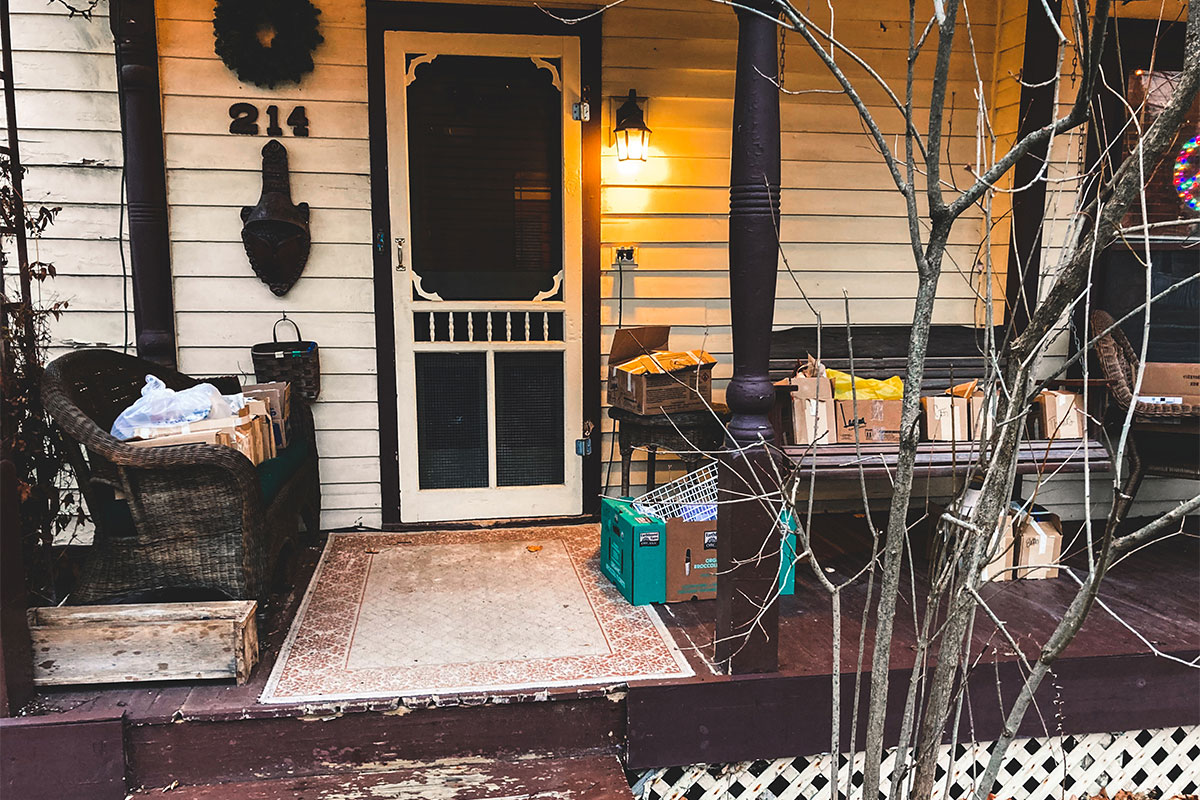
Ceramics teacher’s porch, where students drop off and pick up their projects. Courtesy of Irving Remsen.
By Kristy King
Staff Writer
When surging COVID-19 cases ended mixed mode classes with two days’ notice, WCC was already prepared.
Beginning Nov. 18, Michigan’s Department of Health and Human Services’s emergency order moved most mixed mode classes to online-only. Affected by the order were the construction, manufacturing, auto, robotics, welding, digital media, ceramics, and culinary programs. Healthcare and law enforcement training were exempt from the emergency order.
“There was a lot of planning or thoughts ahead of time. We knew Thanksgiving was going to be that tricky time, especially because universities weren’t going to allow their students back on campus after the holiday anyway,” said Julie Kissel, president of the WCC Education Association.
The college was already telling teachers to “front load as much as they need to” in case a campus closure were to happen. “‘Don’t wait to get the big stuff done,’ was all a part of the long-term planning that started this past summer,” Kissel said.
Instructors said adapting to this year has been a learning experience for them, too. But, in anticipation of a closure, they spent time preparing to go virtual.
“The great thing about people is that we are infinitely adjustable and creative in our own ways in handling situations,” said Irving Remsen, ceramics instructor at Washtenaw Community College.
Remsen and his students are continuing to be creative not just in their artwork, but also in how they complete assignments. Students leave their ceramics pieces on Remsen’s porch for him to fire. After being fired, they are placed back on his porch for students to pick up.
Curbside pickup has been crucial throughout the semester, but it is especially vital now that classes are no longer meeting, so that students still have access to their courses’ necessary equipment.
“Having the support of Dean (Eva) Samulski to keep the equipment room open so we could continue the curbside rotation, that was huge,” said Matthew Zacharias, video professor at WCC.
“She deserves a lot of credit for making that happen and enabling us to continue to provide our students access to the equipment,” Zacharias said. “If we weren’t allowed to do that, then they wouldn’t have access to equipment, and if they didn’t have access to equipment then we’d be in trouble.”
“It’s remarkable how resilient people have been during the pandemic along with the kinds of issues the students have faced,” said Terry Abrams, photography professor at WCC. “And that for the most part they are able to continue on and participate in classes”
That’s true for videography student Kevin Smith, 28, a WCC sophomore who said he didn’t plan to take classes because of his hesitations with COVID-19 and how things would work.
“If it wasn’t for my professor, I wouldn’t be taking classes,” said Smith.
“Once I found out that there were mixed mode classes and that I had the option to go, it made me want to return; it made me want to learn; it made me continue to want to go to school there, once I knew I was still going to get the assistance I needed,” Smith said.
The school provided Smith with a laptop for his editing projects since on-campus time was limited. He will have to return it at the end of the semester.
The photography department has also loaned equipment out to students for the semester.
“All of us have collectively been united to do everything we can to take care of our students, and I’m not exaggerating when I say that,” Zacharias said. “I think it’s a fact.”
Instructor’s preparation before the semester, along with the support from WCC helped ease the transition from mixed mode to virtual.
“Vice president (Kim) Hurns was all about doing things as safely as possible, but at the same time doing things,” Zacharias said. “Let’s get back to school, as long as we can do it safely.”
Other students have struggled with mixed mode classes as well.
“There are definitely pros to mixed mode classes like having additional time to work on assignments,” said Shelby Keil, 21, a communications major at WCC. “However, it has made technical things far more difficult, so I would go in early and stay late with what was allowed.”
Still, Keil and professors found positives to meeting virtually.
“Professors would go above and beyond, doing meetings on Sundays sometimes, to accommodate everyone’s schedule to make sure we understood the technical aspects of the material,” said Keil.
“You physically can’t engage online with students like how you would in a ‘normal’ classroom setting with having fixed stations and rows for students,” Abrams said. “But on Zoom everyone is in the front row. That feels in an odd way more personal. However, if people don’t have their cameras on, it can feel more anonymous and less personal.”
The initial order to pause on-campus instruction allowed healthcare students to continue their classes in person. On Monday, the order was extended until Dec. 20, but allowed the college to resume occupational training, such as construction, manufacturing, auto, robotics, and welding, said Kim Hurns, vice president of instruction.
The art, ceramics, culinary and digital media programs will continue to operate virtually for the rest of the semester.
